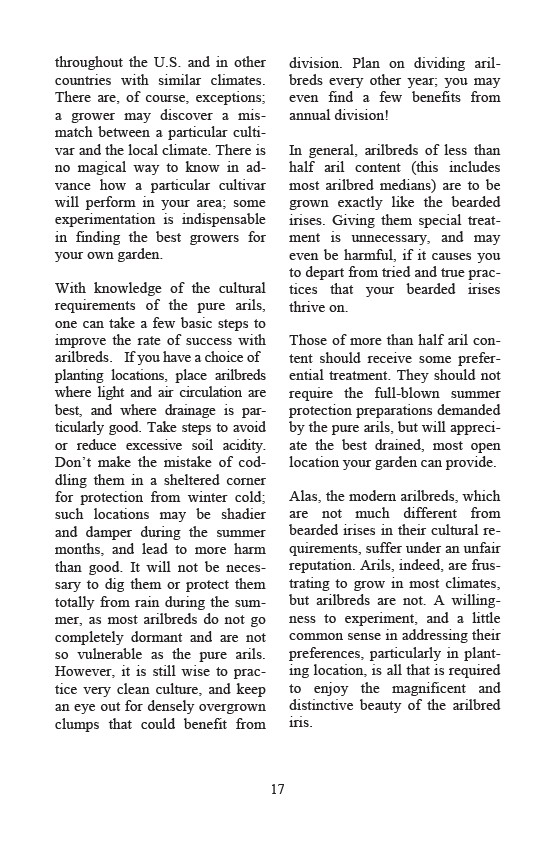
17
throughout the U.S. and in other
countries with similar climates.
There are, of course, exceptions;
a grower may discover a mis-match
between a particular culti-var
and the local climate. There is
no magical way to know in ad-vance
how a particular cultivar
will perform in your area; some
experimentation is indispensable
in finding the best growers for
your own garden.
With knowledge of the cultural
requirements of the pure arils,
one can take a few basic steps to
improve the rate of success with
arilbreds. If you have a choice of
planting locations, place arilbreds
where light and air circulation are
best, and where drainage is par-ticularly
good. Take steps to avoid
or reduce excessive soil acidity.
Don‟t make the mistake of cod-dling
them in a sheltered corner
for protection from winter cold;
such locations may be shadier
and damper during the summer
months, and lead to more harm
than good. It will not be neces-sary
to dig them or protect them
totally from rain during the sum-mer,
as most arilbreds do not go
completely dormant and are not
so vulnerable as the pure arils.
However, it is still wise to prac-tice
very clean culture, and keep
an eye out for densely overgrown
clumps that could benefit from
division. Plan on dividing aril-breds
every other year; you may
even find a few benefits from
annual division!
In general, arilbreds of less than
half aril content (this includes
most arilbred medians) are to be
grown exactly like the bearded
irises. Giving them special treat-ment
is unnecessary, and may
even be harmful, if it causes you
to depart from tried and true prac-tices
that your bearded irises
thrive on.
Those of more than half aril con-tent
should receive some prefer-ential
treatment. They should not
require the full-blown summer
protection preparations demanded
by the pure arils, but will appreci-ate
the best drained, most open
location your garden can provide.
Alas, the modern arilbreds, which
are not much different from
bearded irises in their cultural re-quirements,
suffer under an unfair
reputation. Arils, indeed, are frus-trating
to grow in most climates,
but arilbreds are not. A willing-ness
to experiment, and a little
common sense in addressing their
preferences, particularly in plant-ing
location, is all that is required
to enjoy the magnificent and
distinctive beauty of the arilbred
iris.